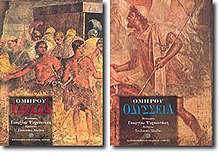George Psychoundakis
This article needs additional citations for verification. (January 2013) |

George Psychoundakis
He had been a shepherd before the war and after it a charcoal burner and later caretaker of a German military cemetery on Crete.
Early life
George Psychoundakis was born in Asi Gonia (Greek: Ασή Γωνιά), a village of a few hundred people high in the Mouselas valley in western Crete. The village was not serviced by a road until the 1950s. He was the penultimate son of Nicolas and Angeliké. One of the poorest families in the village, they lived in a one-room home with an earth floor. After a minimum of education in the village school, he became a shepherd, tending his family's few sheep and goats. He developed an intimate knowledge of his part of the island.
During the Second World War, people used the caves to live in and to store weapons. They traveled the goat tracks to carry messages, goods and people. Crete had a tradition of resistance to rule by outsiders; the island had, about 40 years previously in 1898, obtained its independence from the Ottoman Empire. Numerous insurrections during the long occupation, together with the mountainous terrain, helped maintain an independence of character and willingness to bear and use arms.[1]
Wartime service

As an airborne
Leigh Fermor described the man in his introduction to The Cretan Runner:
When the moon rose he got up and threw a last swig of raki down his throat with the words Another drop of petrol for the engine, and loped towards the gap in the bushes with the furtiveness of a stage Mohican or Groucho Marx. He turned round when he was on all fours at the exit, rolled his eyes, raised a forefinger portentously, whispered, "the Intelligence Service", and scuttled through like a rabbit. A few minutes later we could see his small figure a mile away moving across the next moonlit fold of the foothills of the White Mountains, bound for another fifty-mile journey.[2]
The Cretan runners performed exceptional feats and made essential contributions to the British operations in the Mediterranean. In 490 BC
The resistance fighters faced baking Cretan summers and severely cold winters, particularly in the hills. Food was often short and fighters suffered from hiding in cold, dripping caves with deep snow outside. The island's fighters were never put to the ultimate test; they had hoped Crete might be a starting point for the invasion of southern Europe. The island was liberated in 1945. The British offered Psychoundakis payment for his work, but he turned them down. He said that he had worked for his country and not for money.
Postwar life

After the liberation, Psychoundakis was arrested as a deserter and was confined for 16 months despite having been honoured by the British with BEM (Medal of the Order of the British Empire for Meritorious Service) and £200 as an award for his services during the war. While in confinement he wrote his memories of service in the SOE and the Cretan resistance movement. His former superior Patrick Leigh Fermor, later Sir Patrick, discovered his plight by accident and managed to secure his release by clearing up the misunderstanding.
After reading his manuscript, Leigh Fermor translated it into English, and assisted in getting it published, under the title
Psychoundakis made considerable contributions to Cretan culture. He learned much of Crete's tradition of oral poetry and also wrote. Psychoundakis translated Homer's works, Iliad (560 pages) and Odyssey (474 pages), from ancient Greek into Cretan dialect. For this he was honoured by the Academy of Athens.[4]
From 1974 until his retirement, Psychoundakis, together with another fighter in the Greek resistance,
Sources
- Dillon, John, "The Cretan Runner: George Psychoundakis story", Battle of Crete, UK: My Crete, archived from the original on 3 March 2016, retrieved 16 February 2009
- Helland, Frode Inge (11 October 2005), "Personal interview with Georgio Psychoundakis", Chania.
- George Psychoundakis obituary, Times Online, 23 February 2006.
- George Psychoundakis obituary, The Daily Telegraph, 18 February 2006.
- George Psychoundakis obituary, The Guardian, 21 February 2006.
- The Trireme Trust – Newsletter 18
Bibliography
- Psychoundakis, Georgio (1991) [1955], The Cretan Runner: His Story of the German Occupation, Fermor, PL transl, ISBN 0-7195-3475-5[6]
- Ομήρου Ιλιάδα, Ψυχουντάκης, Γεώργιος. Πανεπιστημιακές Εκδόσεις Κρήτης, Ηράκλειο 2003. ISBN 978-960-7309-92-1
- Ομήρου Οδύσσεια, Ψυχουντάκης, Γεώργιος. Πανεπιστημιακές Εκδόσεις Κρήτης, Ηράκλειο 2003. ISBN 978-960-524-020-2
- Αετοφωλιές στην Κρήτη: Λαογραφία της Ασή-Γωνιάς. Γεώργιος Ψυχουντάκης, Δημοτική Πολιτιστική Επιχείρηση Χανίων. Χανιά 1999.
- Ησίοδου Έργα και Ημέραι: σε έμμετρη μετάφραση. Γεωργίου Ψυχουντάκη, ΕΚΔΟΣΕΙΣ ΕΡΕΙΣΜΑ
References
- ^ Fermor, Patrick Leigh (1955), "Introduction", in Psychoundakis, George (ed.), The Cretan Runner, London: John Murray.
- ^ Psychoundakis, George (1998), The Cretan Runner (paperback ed.), Penguin Books, p. 3.
- ^ "Film reviews Visual Anthropology". Academia.edu. Retrieved 8 August 2015.
- ^ Hoyle, Ben, Times (online ed.), London, UK.
- ^ Beevor, Antony (1991), Crete The Battle and the Resistance, John Murray, pp. 342–43.
- ^ Psychoundakis, George (8 August 2009). "The Cretan Runner". London: Guardian. Retrieved 1 February 2013.
